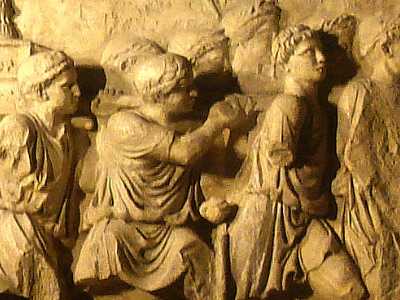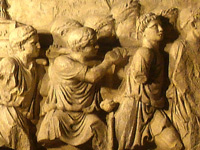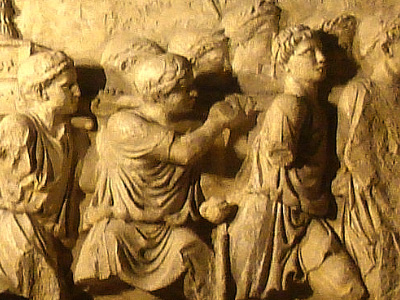Vandalic War (533-534 AD)

The War
Belisarius' army sails to Africa
Amidst much pomp and ceremony, with Justinian and the Patriarch of Constantinople in attendance, the Roman fleet set sail around 21 June 533. The initial progress was slow, as the fleet spent five days at Heraclea Perinthus waiting for horses and further four days at Abydus due to lack of wind. The fleet left the Dardanelles on 1 July, and crossed the Aegean Sea to the port of Methone, where it was joined by the last contingents of troops. Belisarius took advantage of an enforced stay there due to a lull in the wind to train his troops and acquaint the disparate contingents with each other. It was at Methone, however, that 500 men died of dysentery caused by mouldy bread. According to Procopius, the responsibility fell on John the Cappadocian, who had cut costs by baking it only once, with the result that the bread went bad. Justinian was informed, but John does not appear to have been punished. Belisarius took steps to remedy the situation, and the army soon recovered.
From Methone, the fleet sailed up the Ionian Sea to Zacynthus, from where they crossed over to Italy. The crossing took longer than expected due to lack of wind, and the army suffered of lack of fresh water when the supplies they had brought aboard went bad. Eventually, the fleet reached Catania in Sicily, from where Belisarius sent Procopius ahead to Syracuse to gather intelligence on the Vandals' activities. By chance, Procopius met a merchant friend of his there, whose servant had just arrived from Carthage. The latter informed Procopius that not only were the Vandals unaware of Belisarius' sailing, but that Gelimer, who had just dispatched Tzazon's expedition to Sardinia, was away from Carthage at the small inland town of Hermione. Procopius quickly informed Belisarius, who immediately ordered the army to re-embark and set sail for the African coast. After sailing by Malta, they reached Cape Caputvada on the eastern shore of modern Tunisia some 162 Roman miles (240 km) south from Carthage.
Advance on Carthage and the Battle of Ad Decimum
When the Roman fleet reached Africa, a council was held aboard Belisarius' flagship (The Vandalic War, I.15), where many of his officers advocated an immediate attack on Carthage itself, especially since it was the only fortified city in the Vandal realm, the walls of the other cities having been torn down to prevent a rebellion. Belisarius, however, mindful of the fate of the 468 expedition and wary of an encounter with the Vandal fleet, spoke against it. Thus the army disembarked and built a fortified camp to spend the night.
Belisarius knew that success for his expedition relied on gaining the support of the local population, which had largely retained its Roman identity and to which he presented himself as a liberator. Thus on the next day of the landing, when some of his men stole some fruit from a local orchard, he severely punished them, and assembled the army and exhorted them to maintain discipline and restraint towards the native population, lest they abandon their Roman sympathies and go over to the Vandals. Belisarius' pleas bore results, for, as Procopius reports (The Vandalic War, I.17), "the soldiers behaved with moderation, and they neither began any unjust brawls nor did anything out of the way, and [Belisarius], by displaying great gentleness and kindness, won the Libyans to his side so completely that thereafter he made the journey as if in his own land".
Then the Roman army began its march north, following the coastal road. 300 horse under John the Armenian were detached as an advance guard some 3 miles (4.5 km) in front of the main army, while the 600 Huns covered the army's left flank. Belisarius himself with his bucellarii led up the rear, to guard against any attack from Gelimer, who was known to be in the vicinity. The fleet followed the army, sailing along the coast. The first town they encountered was Syllectum, which was captured by a detachment under Boriades by a ruse. In an attempt to sow division among the Vandals, Belisarius gave a letter written by Justinian and addressed to the Vandal nobles to a captured Vandal messenger, in which the emperor claimed to be campaigning on behalf of the legitimate king Hilderic against the usurper Gelimer. As the messenger was too afraid to deliver the letter, this ploy came to nothing.
Gelimer, in the meantime, upon learning of the Romans' arrival, immediately notified his brother Ammatas in Carthage to assemble the Vandal forces in the vicinity, as well as to execute Hilderic and his relatives, while his secretary Bonifatius was ordered to load the royal treasure on a ship and sail for Spain if the Romans won. Deprived of his best troops, which were with Tzazon, Gelimer contented himself with shadowing the northward march of the Roman army, all the while preparing a decisive engagement before Carthage, at a place called Ad Decimum ("at the tenth [milepost]") where he had ordered Ammatas to bring his forces. The Romans advanced through Thapsus, Leptis Parva and Hadrumetum to Grasse, where for the first time they engaged in a skirmish with the scouts of Gelimer's army. After exchanging blows, both parties retired to their camps. From Grasse, Belisarius turned his army westwards, cutting across the neck of the Cape Bon peninsula. This was the most dangerous part of the route to Carthage, with the fleet out of sight.
Thus, on the morning of 13 September, the tenth day of the march from Caputvada, the Roman army approached Ad Decimum. There Gelimer planned to ambush and encircle them, using a force under his brother Ammatas to block their advance and engage them, while 2,000 men under his nephew Gibamund would attack their left flank, and Gelimer himself with the main army would attack from the rear and completely annihilate the Roman army. In the event, the three forces failed to synchronize exactly: Ammatas arrived early and was killed as he attempted a reconnaissance with a small force by the Roman vanguard, while Gibamund's force was intercepted by the Hunnic flank guard and was utterly destroyed. Unaware of all this, Gelimer marched up with the main army and scattered the Roman advance forces present at Ad Decimum. Victory might have been his, but he then came upon his dead brother's body, and apparently forgot all about the battle. This gave Belisarius the time to rally his troops, come up with his main cavalry force and defeat the disorganized Vandals. Gelimer with the remainder of his forces fled westwards to Numidia. The Battle of Ad Decimum ended in a crushing Roman victory, and Carthage lay open and undefended before Belisarius.

These books are available for download with Apple Books on your Mac or iOS device
Belisarius' entry into Carthage and Gelimer's counterattack
It was only by nightfall, when John the Armenian with his men and the 600 Huns rejoined his army, that Belisarius realized the extent of his victory. The cavalry spent the night at the battlefield. In the next morning, as the infantry (and Antonina) caught up, the whole army made for Carthage, where it arrived as night was falling. The Carthaginians had thrown open the gates and illuminated the city in celebration, but Belisarius, fearing a possible ambush in the darkness and wishing to keep his soldiers under tight control, refrained from entering the city, and encamped before it. In the meantime, the fleet had rounded Cape Bon and, after learning of the Roman victory, had anchored at Stagnum, some 7.5 km from the city. Ignoring Belisarius' instructions, Calonymus and his men proceeded to plunder the merchant settlement of Mandriacum nearby.
On the morning of the next day, 15 September, Belisarius drew up the army for battle before the city walls, but as no enemy appeared, he led his army into the city, after again exhorting his troops to show discipline. The Roman army received a warm welcome from the populace, which was favourably impressed by its restraint. While Belisarius himself took possession of the royal palace, seated himself on the king's throne, and consumed the dinner which Gelimer had confidently ordered to be ready for his own victorious return, the fleet entered the Lake of Tunis and the army was billeted throughout the city. The remaining Vandals were rounded up and placed under guard to prevent them from causing trouble. Belisarius dispatched Solomon to Constantinople to bear the emperor news of the victory, but expecting an imminent re-appearance of Gelimer with his army, he lost no time in repairing the largely ruined walls of the city and rendering it capable of sustaining a siege.
During the following weeks, while Belisarius remained in Carthage strengthening its walls, Gelimer established himself and the remnant of his army at Bulla Regia. By distributing money he had managed to cement the loyalty of the locals to his cause, and sent messages recalling Tzazon and his men from Sardinia, where they had been successful in re-establishing Vandal authority and killing Godas. While waiting for Tzazon's arrival, the Vandal king's army also increased by the arrival of more and more fugitives from the battle of Ad Decimum, as well as by a contingent of his Moorish allies. Most of the Moorish tribes of Numidia and Byzacena, however, sent embassies to Belisarius, pledging allegiance to the Empire. Some even offered hostages and asked for the insignia of office traditionally awarded to them by the emperor: a gilded silver staff and a silver crown, a white cloak, a white tunic, and a gilded boot. Belisarius had been furnished by Justinian with these items in anticipation of this demand, and duly dispatched them along with sums of money. Nevertheless, it was clear that, as long as the outcome of the war remained undecided, neither side could count on the firm loyalty of the Moors. During this period, messengers from Tzazon, sent to announce his recovery of Sardinia, sailed into Carthage unaware that the city had fallen and were taken captive, followed shortly after by Gelimer's envoys to Theudis, who had reached Spain after the news of the Roman successes had arrived there and hence failed to secure an alliance. Belisarius was also reinforced by the Roman general Cyril with his contingent, who had sailed to Sardinia only to find it once again in possession of the Vandals.
As soon as Tzazon received his brother's message, he left Sardinia and landed in Africa, joining up with Gelimer at Bulla. The Vandal king now determined to advance on Carthage. His intentions are not clear; the traditional interpretation is that he hoped to reduce the city by blockading it, but Ian Hughes believes that, lacking the reserves for a protracted war of attrition, he hoped to force Belisarius into a "single, decisive confrontation". Approaching the city, the Vandal army cut the aqueduct supplying it with water, and attempted to prevent provisions from arriving in the city. Gelimer also dispatched agents to the city to undermine the loyalty of the inhabitants and the imperial army. Belisarius, who was alert to the possibility of treachery, set an example by impaling a citizen of Carthage who intended to join the Vandals. The greatest danger for defection came from the Huns, who were disgruntled because they had been ferried to Africa against their will and feared being left there as a garrison. Indeed, Vandal agents had already made contact with them, but Belisarius managed to maintain their allegiance—at least for the moment—by making a solemn promise that after the final victory they would be richly rewarded and allowed to return to their homes. Their loyalty however remained suspect, and, like the Moors, the Huns probably awaited to see who would emerge as the victor and rally to him.
Tricamarum and the surrender of Gelimer
After securing the loyalty of the populace and the army, and completing the repairs to the walls, Belisarius resolved to meet Gelimer in battle, and in mid-December marched out of Carthage in the direction of the fortified Vandal camp at Tricamarum, some 28 km from Carthage. As at Ad Decimum, the Roman cavalry proceeded in advance of the infantry, and the ensuing Battle of Tricamarum was a purely cavalry affair, with Belisarius' army considerably outnumbered. Both armies kept their most untrustworthy elements—the Moors and Huns—in reserve. John the Armenian played the most important role on the Roman side, and Tzazon on the Vandal. John led repeated charges at the Vandal centre, culminating in the death of Tzazon. This was followed by a general Roman attack across the front and the collapse of the Vandal army, which retreated to its camp. Gelimer, seeing that all was lost, fled with a few attendants into the wilds of Numidia, whereupon the remaining Vandals gave up all thoughts of resistance and abandoned their camp to be plundered by the Romans. Like the previous battle at Ad Decimum, it is again notable that Belisarius failed to keep his forces together, and was forced to fight with a considerable numerical disadvantage. The dispersal of his army after the battle, looting heedlessly and leaving themselves vulnerable to a potential Vandal counter-attack was also an indication of the poor discipline in the Roman army and the command difficulties Belisarius faced. As Bury comments, the expedition's fate might have been quite different "if Belisarius had been opposed to a commander of some ability and experience in warfare", and points out that Procopius himself "expresses amazement at the issue of the war, and does not hesitate to regard it not as a feat of superior strategy but as a paradox of fortune".
A Roman detachment under John the Armenian pursued the fleeing Vandal king for five days and nights, and was almost upon him when he was killed in an accident. The Romans halted to mourn their leader, allowing Gelimer to escape, first to Hippo Regius and from there to the city of Medeus on Mount Papua, on whose Moorish inhabitants he could rely. Belisarius sent 400 men under the Herul Pharas to blockade him there. Belisarius himself made for Hippo Regius, where the Vandals who had fled to various sanctuaries surrendered to the Roman general, who promised that they would be well treated and sent to Constantinople in spring. Belisarius was also fortunate in recovering the Vandal royal treasure, which had been loaded in a ship at Hippo. Bonifatius, Gelimer's secretary, was supposed to sail with it to Spain, where Gelimer too would later follow, but adverse winds kept the ship in harbour and in the end, Bonifatius handed it over to the Romans in exchange for his own safety (as well as a considerable share of the treasure, if Procopius is to be believed). Belisarius also began to extend his authority over the more distant provinces and outposts of the Vandal kingdom: Cyril was dispatched to Sardinia and Corsica with Tzazon's head as proof of his victory, John was sent to Caesarea on the coast of Mauretania Caesariensis, another John was sent to the twin fortresses of Septem and Gadira, which controlled the Straits of Gibraltar, and Apollinarius to take possession of the Balearic Islands. Aid was also sent to the provincials in Tripolitania, who had been subject to attacks by the local Moorish tribes. Belisarius also demanded the return of the port of Lilybaeum in western Sicily from the Ostrogoths, who had captured it during the war, as it too had been part of the Vandal kingdom. An exchange of letters followed between Justinian and the Ostrogoth court, through which Justinian was drawn into the intrigues of the latter, leading to the Roman invasion of Italy a year later.
Meanwhile, Gelimer remained blockaded by Pharas at the mountain stronghold of Medeus, but as the blockade dragged through the winter, Pharas grew impatient. He attacked the mountain stronghold, only to be beaten back with the loss of a quarter of his men. While a success for Gelimer, it did not alter his hopeless situation as he and his followers remained tightly blockaded and began to suffer from lack of food. Pharas sent him messages calling upon him to surrender and spare his followers the misery, but it was not until March that the Vandal king agreed to surrender after receiving guarantees for his safety. Gelimer was then escorted to Carthage.
HISTORY

RESOURCES
This article uses material from the Wikipedia article "Vandalic War (533-534 AD)", which is released under the Creative Commons Attribution-Share-Alike License 3.0.
© Stories Preschool. All Rights Reserved.









